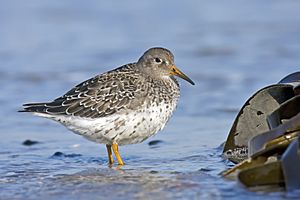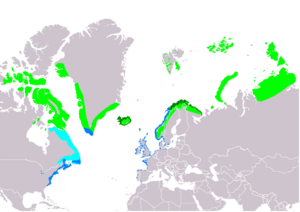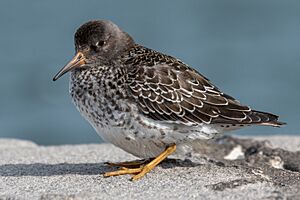Purple sandpiper facts for kids
Quick facts for kids Purple sandpiper |
|
|---|---|
 |
|
| Conservation status | |
| Scientific classification | |
 |
|
| Range of C. maritima Breeding Resident Non-breeding Passage | |
| Synonyms | |
|
The purple sandpiper (Calidris maritima) is a small shorebird that belongs to the sandpiper family, called Scolopacidae. This tough little bird lives and breeds in the cold arctic and subarctic areas of Europe, Asia, and North America. In winter, it flies south to warmer parts of the Atlantic coast.
Contents
About the Purple Sandpiper's Name
The purple sandpiper was first officially described in 1764 by a Danish zoologist named Morten Thrane Brünnich. He gave it the scientific name Tringa maritima. Later, it was moved into a group of 23 other sandpipers called Calidris. This group name comes from an old Greek word, kalidris, which Aristotle used for grey birds found near water. The second part of its name, maritima, is Latin for "of the sea," because it lives by the ocean.
The purple sandpiper is considered a single species, meaning there are no different types or subspecies of it. It is closely related to other sandpipers like the rock sandpiper, sanderling, and dunlin.
What Does a Purple Sandpiper Look Like?
Adult purple sandpipers have short yellow legs and a thin, dark beak with a yellow base. Their bodies are dark on top, with a slight purple shine, and mostly white underneath. Their chest has some grey smudges, and their back end (rump) is black.
These birds are about 20 to 22 centimeters (8 to 9 inches) long. Their wingspan, which is how wide they are with their wings spread, is about 42 to 46 centimeters (17 to 18 inches). They usually weigh between 50 and 105 grams (1.8 to 3.7 ounces).
| Standard Measurements | |
|---|---|
| Total Body Length | 20.6–24.1 cm (8.1–9.5 in) |
| Weight | 70 g (2.5 oz) |
| Wingspan | 43 cm (17 in) |
| Wing | 11.8–13 cm (4.6–5.1 in) |
| Tail | 5.6–6.3 cm (2.2–2.5 in) |
| Culmen | 2.7–3.2 cm (1.1–1.3 in) |
| Tarsus | 2.2–2.4 cm (0.87–0.94 in) |
Where Do Purple Sandpipers Live?
Purple sandpipers breed in the far northern parts of the world. Their breeding grounds stretch from the arctic islands of northern Canada, across Greenland, Iceland, Svalbard, and northern Scandinavia, all the way to Western Siberia.
In the very cold arctic, they nest on low-lying tundra, sometimes far from the coast. In slightly warmer subarctic areas like Sweden and Norway, they breed on bare mountain sides where the ground stays frozen for much of the year.
After breeding, these birds fly south for the winter. They spend the colder months on rocky shores along both sides of the North Atlantic Ocean. In North America, they can be found as far south as South Carolina. Along the eastern Atlantic coast, they winter as far south as France and northern Spain.
Some birds that winter in northern Scotland and southwest Ireland actually fly all the way to Canada (like Baffin Island and Devon Island) to breed.
In Britain, many purple sandpipers arrive in winter, especially along the east and south coasts. They love rocky shorelines right next to the sea. It's very rare for them to breed in the UK, only a few pairs have nested in the Cairngorms National Park since 1978.
These birds are late migrants, meaning they move to their winter homes later than many other birds. They often gather in small groups, sometimes with ruddy turnstones. They are also quite calm and easy to get close to.
Purple Sandpiper Life and Habits
Reproduction and Life Cycle
Purple sandpipers breed in the northern tundra on Arctic islands in Canada and along the coasts of Greenland and northwestern Europe. They can start breeding when they are just one year old.
The male bird digs several small nests on the ground. The female then chooses one of these spots and lays 3 or 4 eggs. These eggs are olive-colored with brown spots and are about 37 by 26 millimeters (1.5 by 1.0 inches) in size.
The male bird does most of the work incubating the eggs, which means keeping them warm until they hatch. The eggs hatch in about 21 to 22 days. The baby chicks are covered in thick, soft down feathers. Their upper parts have black and cinnamon patches with white specks, and their undersides are mostly white.
Usually, only the male parent takes care of the chicks, which can find their own food soon after hatching. The oldest purple sandpiper ever recorded in Europe lived for 20 years and 9 months! This was discovered through bird banding data in Sweden.
What Do Purple Sandpipers Eat?
These birds search for food on rocky coasts. They mostly pick up food they see. Their diet mainly includes small insects and shellfish, especially periwinkles and mussels. They also eat some plant material. One of their favorite foods is seaweed flies, especially those from the Coelopa group.
Conservation Status
The purple sandpiper lives across a very large area. Even though the number of these birds seems to be going down, the total population is still very big. Because of this, the International Union for Conservation for Nature (IUCN) has decided that the species is of "Least concern" for extinction. This means they are not currently in danger. The purple sandpiper is also protected by an agreement called the Agreement on the Conservation of African-Eurasian Migratory Waterbirds (AEWA).





